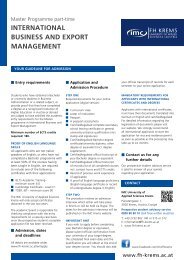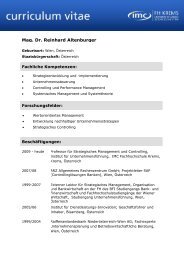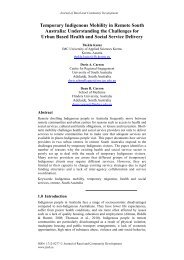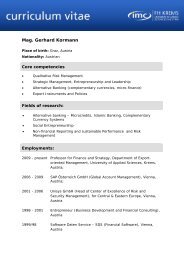Nokia falls into the arms of Microsoft
Nokia falls into the arms of Microsoft
Nokia falls into the arms of Microsoft
Create successful ePaper yourself
Turn your PDF publications into a flip-book with our unique Google optimized e-Paper software.
Because <strong>of</strong> <strong>the</strong> variety <strong>of</strong> topics (also resembling <strong>the</strong> chair-structure <strong>of</strong> <strong>the</strong><br />
Export-oriented Management programme), applicants receive 2 texts with<br />
different focus areas, and select <strong>the</strong> one that <strong>the</strong>y prefer to discuss. We<br />
want to give applicants a good chance that <strong>the</strong>y get a text <strong>the</strong>y want to<br />
work with. A selection <strong>of</strong> texts used for <strong>the</strong> application process (admission<br />
<strong>of</strong> <strong>the</strong> 2011/12 cohort) can be found below; <strong>the</strong> articles might be a good<br />
read, actually. Enjoy!<br />
<strong>Nokia</strong> <strong>falls</strong> <strong>into</strong> <strong>the</strong> <strong>arms</strong> <strong>of</strong><br />
Micros<strong>of</strong>t<br />
Feb 11th 2011, 9:57 by The Economist online<br />
IT LOOKS, in a way, like a stealth takeover. In September Stephen Elop,<br />
one <strong>of</strong> Micros<strong>of</strong>t's leading lights, becomes boss <strong>of</strong> <strong>Nokia</strong>, a troubled<br />
Finnish handset-maker. Five months later, Mr Elop will make Windows<br />
Phone, Micros<strong>of</strong>t's operating system for smartphones, its "primary<br />
platform" for such devices. Yet this is only one <strong>of</strong> <strong>the</strong> radical decisions<br />
<strong>Nokia</strong>'s new boss announced on February 11th, shortly after sending his<br />
staff an apocalyptic memo warning <strong>the</strong>m that <strong>the</strong>y were standing on a<br />
burning oil platform and risked being consumed by <strong>the</strong> flames. The firm<br />
will henceforth have just two distinct businesses, smartphones and massmarket<br />
mobiles, and get a new operational structure and leadership team,<br />
more <strong>of</strong> whom will come from outside Finland.<br />
This is an astonishing upheaval for what was once one <strong>of</strong> Europe‟s hottest<br />
firms. <strong>Nokia</strong>‟s problems are symptomatic for much <strong>of</strong> Europe‟s mobilephone<br />
industry. In <strong>the</strong> 1990s Europe appeared to have beaten even<br />
Silicon Valley in mobile technology. European telecoms firms had settled<br />
on a single standard for mobile phones. Handsets became affordable,
Europe was <strong>the</strong> biggest market for <strong>the</strong>m and <strong>the</strong> old continent‟s standard<br />
took over <strong>the</strong> world, with Europe leading <strong>the</strong> way with constant<br />
innovation.<br />
This changed with <strong>the</strong> emergence <strong>of</strong> smartphones, in particular Apple‟s<br />
iPhone in 2007. <strong>Nokia</strong> still ships a third <strong>of</strong> all handsets, but Apple pulls in<br />
more than half <strong>of</strong> <strong>the</strong> pr<strong>of</strong>its, despite having a market share <strong>of</strong> barely 4%.<br />
More Americans now have smartphones than Europeans.<br />
<strong>Nokia</strong>, along with <strong>the</strong> rest <strong>of</strong> Europe‟s mobile industry, is also being<br />
squeezed in both simple handsets and networking equipment. Cheap<br />
mobile phones based on chips from MediaTek, a company based in<br />
Taiwan, are increasingly popular in developing countries. This system and<br />
its users now account for more than one-third <strong>of</strong> <strong>the</strong> phones sold globally.<br />
At its most fundamental, this shift is <strong>the</strong> result <strong>of</strong> Moore‟s Law, which<br />
holds that microprocessors double in computing power every 18 months.<br />
The first generations <strong>of</strong> modern mobile phones were purely devices for<br />
conversation and text messages. The money lay in designing desirable<br />
handsets, manufacturing <strong>the</strong>m cheaply and distributing <strong>the</strong>m widely. This<br />
played to European strengths. The necessary skills overlapped most <strong>of</strong> all<br />
in Finland, which explains why <strong>Nokia</strong>, a company that grew up producing<br />
rubber boots and paper, could become <strong>the</strong> world leader in handsets.<br />
Nowadays <strong>the</strong> focus is on s<strong>of</strong>tware and data services. This is where<br />
America, in particular Silicon Valley, is hard to beat. Companies like Apple<br />
and Google know how to build overarching technology platforms. And <strong>the</strong><br />
Valley boasts an unparalleled ecosystem <strong>of</strong> entrepreneurs, venture<br />
capitalists and s<strong>of</strong>tware developers who regularly spawn innovative<br />
services.
The perils <strong>of</strong> dallying<br />
<strong>Nokia</strong> realised its world was changing and was working on a touch-screen<br />
phone much like <strong>the</strong> iPhone as early as 2004. Realising <strong>the</strong> importance <strong>of</strong><br />
mobile services, it launched Ovi, an online storefront for such things in<br />
2007, a year before Apple opened its highly successful App Store.<br />
But turning a Finnish hardware-maker <strong>into</strong> a provider <strong>of</strong> s<strong>of</strong>tware and<br />
services is no easy undertaking. <strong>Nokia</strong> dallied and lost <strong>the</strong> initiative.<br />
Historically, <strong>Nokia</strong> has been a highly efficient manufacturing and logistics<br />
machine capable <strong>of</strong> churning out a dozen handsets a second and selling<br />
<strong>the</strong>m all over <strong>the</strong> world. Planning was long-term and new devices were<br />
developed by separate teams, sometimes competing with each o<strong>the</strong>r—<strong>the</strong><br />
opposite <strong>of</strong> what is needed in s<strong>of</strong>tware, where <strong>the</strong>re is a premium on<br />
collaborating and doing things quickly.<br />
Teaming up with Micros<strong>of</strong>t has its benefits, says Ben Wood <strong>of</strong> CCS Insight,<br />
ano<strong>the</strong>r market-research firm. Given his background, Mr Elop could surely<br />
make such a partnership work. And it could help <strong>Nokia</strong> make a comeback<br />
in America, where its market share is in <strong>the</strong> low single digits. On <strong>the</strong> o<strong>the</strong>r<br />
hand, argues Mr Wood, Windows Phone 7 has not been a huge success so<br />
far<br />
Still, <strong>the</strong> partnership is good news for Micros<strong>of</strong>t, which has struggled to<br />
create momentum behind Windows Phone 7 despite a huge investment in<br />
development and marketing. Both firms will now focus on establishing <strong>the</strong><br />
platform as an alternative to Android and <strong>the</strong> iPhone.<br />
QUESTION 1: Please summarise <strong>the</strong> article so that you can explain <strong>the</strong> main points in<br />
2-3 minutes.<br />
QUESTION 2: Why are more and more people switching to smartphones?<br />
QUESTION 3: <strong>Nokia</strong> is also producing a range <strong>of</strong> smartphones. Why is<br />
<strong>Nokia</strong> still losing ground to Apple and o<strong>the</strong>r manufacturers?
Who needs paper?<br />
A new digital paper tests a new<br />
model for news<br />
Rupert Murdoch's iPad Daily<br />
Feb 3rd 2011 | from ECONOMIST PRINT EDITION<br />
EIGHT years ago Apple launched iTunes, a digital store selling music<br />
singles for 99 cents apiece. For record companies ravaged by piracy, it<br />
seemed like a good deal. Only later did many come to regret allowing<br />
ano<strong>the</strong>r company to set retail prices and to get between <strong>the</strong>m and <strong>the</strong>ir<br />
customers. On February 2nd Apple and Rupert Murdoch‟s News<br />
Corporation launched <strong>the</strong> Daily, an iPad newspaper that will cost 99 cents<br />
a week. It will not dominate <strong>the</strong> digital news market <strong>the</strong> way iTunes came<br />
to rule <strong>the</strong> digital music market. But it sets a disruptive precedent or two.<br />
The Daily is a mixture <strong>of</strong> <strong>the</strong> newfangled and <strong>the</strong> old-fashioned. It has<br />
whizzy graphics, including video and “360-degree” pictures. Sport fans<br />
can receive <strong>the</strong> twitterings <strong>of</strong> <strong>the</strong>ir favourite players. Unlike most<br />
websites, though, <strong>the</strong> Daily is available only in America. It features<br />
outmoded things such as editorials and paid reporters. Although it can be<br />
updated to take in breaking news, it is primarily a daily, not an hourly.<br />
In one sense it is a trailblazer. The Daily is <strong>the</strong> first product to <strong>of</strong>fer<br />
recurring subscriptions through Apple‟s store. So far most publishers have<br />
been obliged to sell single issues <strong>of</strong> newspapers and magazines on <strong>the</strong><br />
iPad. As a result, sales are erratic: Wired, a technology magazine with a<br />
beautiful app, sold 100,000 digital copies last June but just 24,400 in<br />
December. The Daily‟s sales model is better than that. But not much<br />
better.<br />
There is <strong>the</strong> price, for one thing. Ken Doctor, <strong>the</strong> author <strong>of</strong><br />
“Newsonomics”, reckons many people will be willing to pay 99 cents a<br />
week for news. That “what-<strong>the</strong>-hell price” could become a benchmark. The<br />
Daily is thinly staffed and will cost less than half a million dollars a week<br />
to put out. Many established newspapers and magazines, including some<br />
owned by News Corporation, want to charge considerably more than 99<br />
cents a week. They believe <strong>the</strong> experience <strong>of</strong> reading a newspaper or<br />
magazine on <strong>the</strong> iPad is a good substitute for <strong>the</strong> original thing, and fear<br />
undercutting <strong>the</strong>ir paper products.
They have a bigger worry. In <strong>the</strong> absence <strong>of</strong> a means to sell subscriptions<br />
through <strong>the</strong> app store, publications from People magazine to The<br />
Economist to News Corporation‟s Wall Street Journal have deployed <strong>the</strong>ir<br />
own systems for controlling access. Some sell single issues while allowing<br />
free access to people who already pay for <strong>the</strong> paper or web product<br />
(“existing print subscribers click here”). In effect, <strong>the</strong>y are using <strong>the</strong> iPad<br />
as a delivery system for content paid for outside Apple‟s ecosystem. That<br />
means Apple does not take a 30% cut <strong>of</strong> sales. More important,<br />
particularly for ad-dependent American publications, it means <strong>the</strong>y can<br />
keep tabs on subscribers.<br />
This opportunity may be closing. In <strong>the</strong> past month Apple has advised at<br />
least two European publishers to stop bypassing its payment system. It is<br />
unclear whe<strong>the</strong>r, having set up a subscription system for <strong>the</strong> Daily, Apple<br />
will try to force publishers to use it. As Mr Murdoch acknowledged this<br />
week, Apple rules <strong>the</strong> tablet market. Publishers have come to wish it were<br />
not so.<br />
The Daily totaled $30 million to set up and will cost $500,000 to run<br />
weekly. Subscription will be <strong>the</strong> larger part <strong>of</strong> <strong>the</strong>ir revenue model at first,<br />
but <strong>the</strong>y expect to be moving towards a 50/50 revenue split with ads later<br />
in <strong>the</strong> year. Launch advertisers include HBO, Macy‟s, Paramount, Pepsi<br />
Max, Range Rover, Verizon, and Virgin Atlantic Airways.<br />
Murdoch expects The Daily to be on all major tablets, but says “last year,<br />
this year and maybe next year belong to iPad.” Murdoch sees <strong>the</strong> The<br />
Daily has a revival <strong>of</strong> quality journalism in <strong>the</strong> digital realm.<br />
Murdoch‟s o<strong>the</strong>r publications, The Wall Street Journal, The Times and The<br />
Sunday Times, have all introduced paywalls for <strong>the</strong>ir websites. The Daily<br />
joins <strong>the</strong> ranks <strong>of</strong> o<strong>the</strong>r paid-for newspaper apps on <strong>the</strong> iPad including<br />
Esquire, <strong>the</strong> New Yorker, Vanity Fair and Glamour.<br />
QUESTION 1: Please summarise <strong>the</strong> article so that you can explain <strong>the</strong> main points in<br />
2-3 minutes.<br />
QUESTION 2: What is <strong>the</strong> role <strong>of</strong> newspapers today?<br />
QUESTION 3: How does a newspaper generate revenue?
The abominable gas man:<br />
How technological change and<br />
new pipelines improve energy<br />
security<br />
Europe's gas pipelines<br />
Oct 14th 2010 | from ECONOMIST PRINT EDITION<br />
FOR years, <strong>the</strong> idea that Europe might get gas from <strong>the</strong> Caucasus and<br />
beyond, breaking Russia‟s monopoly on east-west pipelines, seemed<br />
fanciful. Not anymore. The leading contender, <strong>the</strong> Nabucco pipeline,<br />
backed by <strong>the</strong> European Union, is gaining speed (see map). Last month<br />
<strong>the</strong> project won promises <strong>of</strong> $5 billion in loans from <strong>the</strong> World Bank, <strong>the</strong><br />
European Investment Bank and <strong>the</strong> European Bank for Reconstruction and<br />
Development.<br />
Nabucco is not yet a done deal. Two big members <strong>of</strong> <strong>the</strong> consortium, RWE<br />
<strong>of</strong> Germany and OMV <strong>of</strong> Austria, said on October 8th that <strong>the</strong>y had<br />
postponed to next year a final decision on whe<strong>the</strong>r to invest.<br />
Ano<strong>the</strong>r problem is <strong>the</strong> source <strong>of</strong> gas. At first Nabucco needs 8 billion<br />
cubic metres (bcm) a year from Azerbaijan, but it wants a lot more to be
fully viable. Turkmenistan is <strong>the</strong> best option: it has fallen out with Russia,<br />
thawed relations with Azerbaijan, and built a pipeline from its onshore<br />
gasfields to <strong>the</strong> Caspian coast. Gas could continue from <strong>the</strong>re ei<strong>the</strong>r by a<br />
pipeline across <strong>the</strong> Caspian (though Russia objects) or, more<br />
cumbersomely, by tanker.<br />
Nabucco is not <strong>the</strong> only party interested in Azeri gas. The authorities in<br />
Baku continue to flirt with Russia (though any pipeline going northward<br />
would have to cross <strong>the</strong> unstable north Caucasus). Two rival projects aim<br />
to bring Azeri gas to sou<strong>the</strong>rn Italy via Turkey and Greece. That would not<br />
help gas-hungry central Europe. But <strong>the</strong> costs and politics <strong>of</strong> <strong>the</strong> Adriatic<br />
route are simpler.<br />
As Turkey flexes its muscles, o<strong>the</strong>r countries plot to bypass it. A new<br />
scheme, <strong>the</strong> Azerbaijan-Georgia-Romania Interconnector (AGRI), aims to<br />
use an existing trans-Caucasus pipeline, and <strong>the</strong>n tankers across <strong>the</strong> Black<br />
Sea. From <strong>the</strong> Romanian port <strong>of</strong> Constanta, it would <strong>the</strong>n go through an<br />
existing pipeline to Hungary. AGRI will not carry as much gas as<br />
Nabucco‟s planned annual target <strong>of</strong> 38 bcm. But it is cheaper to build,<br />
costing perhaps €1.2 billion ($1 billion), and will save on Turkish transit<br />
fees.<br />
For its part, Russia is continuing to push its rival South Stream project,<br />
which would go, expensively, across <strong>the</strong> bottom <strong>of</strong> <strong>the</strong> Black Sea,<br />
bypassing Ukraine. But crucial bits are missing. Russia‟s ill-run and debtridden<br />
gas industry has little extra capacity. Bulgaria is still furious about<br />
having its gas supplies cut <strong>of</strong>f during <strong>the</strong> Russian-Ukrainian gas row in<br />
January 2009. S<strong>of</strong>ia wants to lessen <strong>the</strong> country‟s energy dependence on<br />
Russia, not increase it.<br />
Russia may be down, but it is not out. The Nord Stream pipeline on <strong>the</strong><br />
Baltic seabed is being built, bringing Russian gas directly to Germany and<br />
reducing dependence on transit countries such as Belarus and Ukraine.<br />
Russia‟s new gas contract with Poland could tie that country to supplies<br />
from <strong>the</strong> east until 2037.<br />
Stealthily but successfully, <strong>the</strong> commission has been liberalising Europe‟s<br />
gas market. A new directive makes it compulsory for all gas pipelines to<br />
be reversible, meaning that <strong>the</strong>y can be used not just for funnelling gas<br />
<strong>into</strong> Europe, but also for moving it around <strong>the</strong> continent. That weakens<br />
<strong>the</strong> position <strong>of</strong> monopoly suppliers such as Russia.<br />
The most important shift, however, is not on land but at sea. The big<br />
worries over European energy security came when <strong>the</strong> world gas market<br />
was tight. But <strong>the</strong> price <strong>of</strong> gas has plunged, chiefly because America, now<br />
well supplied with shale gas, has stopped importing it.<br />
Nabucco remains important as an insurance policy, and as a sign that <strong>the</strong><br />
EU‟s common energy policy is more than talk. But it also looks like an
answer to a problem that technology and <strong>the</strong> market may already be<br />
solving.<br />
QUESTION 1: Please summarise <strong>the</strong> article so that you can explain <strong>the</strong> main<br />
points in 2-3 minutes.<br />
QUESTION 2: What do we need (natural) gas for?<br />
QUESTION 3: Why is <strong>the</strong>re such a strong political debate on gas supply?<br />
The takeover <strong>of</strong> Cadbury by Kraft<br />
seems to symbolise a hollowingout<br />
<strong>of</strong> corporate Britain. The<br />
truth is ra<strong>the</strong>r more complicated<br />
Foreign takeovers in Britain<br />
Mar 25th 2010 | from ECONOMIST PRINT EDITION<br />
THE Thames Valley provides two contrasting examples <strong>of</strong> what happens<br />
when foreign companies buy British ones. Any day now <strong>the</strong> Scottish &<br />
Newcastle (S&N) brewery beside <strong>the</strong> M4 motorway at Reading will brew its<br />
last barrel after more than 150 years <strong>of</strong> operation. Its closure was
announced two years ago, weeks after S&N was bought by Carlsberg, <strong>of</strong><br />
Denmark, and Heineken, <strong>of</strong> <strong>the</strong> Ne<strong>the</strong>rlands, and carved up between<br />
<strong>the</strong>m. There‟s little <strong>of</strong> Scotland, Newcastle or Berkshire left in what is now<br />
Heineken UK, a subsidiary <strong>of</strong> a Dutch lager-maker. Heads <strong>of</strong> departments<br />
such as marketing and product development are now in Amsterdam.<br />
About 40km to <strong>the</strong> north, <strong>the</strong> BMW MINI factory in Oxford makes more<br />
than 200,000 cars a year. MINI is a survivor <strong>of</strong> BMW‟s o<strong>the</strong>rwise failed<br />
attempt to turn around Britain‟s ailing Rover group in <strong>the</strong> 1990s. Whereas<br />
<strong>the</strong> original Mini sold in large numbers but was an underpriced lossmaker,<br />
foreign ownership and capital have made <strong>the</strong> new version a global<br />
commercial success. Four out <strong>of</strong> five cars made in Oxford are exported;<br />
one in six BMWs sold is a MINI. The o<strong>the</strong>r surviving bit <strong>of</strong> Rover, Jaguar<br />
Land Rover, is on its third foreign owner—Tata Motors, <strong>of</strong> India—after<br />
Ford failed to turn it round. Tata‟s first move was to proclaim a ten-year<br />
plan to develop <strong>the</strong> two British brands; <strong>the</strong>ir outlook is at last looking<br />
brighter.<br />
Britons <strong>the</strong>se days are more likely to be found crying <strong>into</strong> <strong>the</strong>ir beer than<br />
celebrating successes like MINI. Cadbury, a venerable chocolate-maker, is<br />
just <strong>the</strong> latest household name to be swallowed by foreigners after a<br />
hostile takeover bid. Its recent purchase by Kraft Foods, an American<br />
company, has come to illustrate a complex set <strong>of</strong> anxieties: that Britain<br />
will lose jobs and skills, and that whereas British firms are open to<br />
takeover, <strong>the</strong>ir foreign predators are <strong>of</strong>ten protected against becoming<br />
prey <strong>the</strong>mselves. There is something to <strong>the</strong>se worries, but it is far from<br />
clear that Britain is a net loser. Purchases go both ways—and many British<br />
firms have found new strength under foreign owners.<br />
For 30 years <strong>the</strong> consensus has been that Britain has more to gain than to<br />
lose from its open embrace <strong>of</strong> globalisation. It has welcomed <strong>the</strong> presence<br />
<strong>of</strong> foreign investors, by and large, as a vote <strong>of</strong> confidence in <strong>the</strong> country‟s<br />
business climate. British companies have also been eager purchasers<br />
abroad: this month Prudential, an insurer, agreed to pay $35.5 billion for<br />
<strong>the</strong> Asian assets <strong>of</strong> once-mighty American International Group.<br />
Repatriated earnings have flowed <strong>into</strong> British pension funds.<br />
Britain has enjoyed a strong inflow <strong>of</strong> foreign direct investment. It has<br />
consistently attracted more than any o<strong>the</strong>r European country. According<br />
to Dealogic, a financial-information firm, foreigners have spent $1 trillion<br />
on acquiring 5,400 British companies in <strong>the</strong> past decade. The British have<br />
spent less on foreign firms, $750 billion, but have snapped up a larger<br />
number, just over 6,000 (see chart).
Now Britons aren‟t so sure that <strong>the</strong>y have got a good deal and fear factory<br />
closures and job losses. As head <strong>of</strong>fices close, power shifts abroad and<br />
Britain risks becoming a “branch factory” economy. When companies need<br />
to cut capacity, <strong>the</strong>y will chop factories far from home first. Renault shut<br />
its Belgian factory in <strong>the</strong> late 1990s, ra<strong>the</strong>r than close one in France;<br />
Peugeot closed its British one a few years ago for <strong>the</strong> same reason. Kraft‟s<br />
purchase <strong>of</strong> Cadbury has also touched this nerve. Cadbury had intended to<br />
close its factory at Keynsham, near Bristol; Kraft said during <strong>the</strong> takeover<br />
battle that it would keep <strong>the</strong> plant open, but <strong>the</strong>n changed its mind.<br />
The worry is not just about <strong>the</strong> quantity <strong>of</strong> jobs but also about <strong>the</strong>ir<br />
quality. The moan is that high-value head-<strong>of</strong>fice jobs and R&D skills will<br />
drift abroad. For Cadbury this means that as <strong>the</strong> head <strong>of</strong>fice in Uxbridge<br />
yields to Kraft‟s in Illinois, British knowledge will be dissipated. Talented<br />
Britons may have to search for work abroad if <strong>the</strong>re are fewer outlets for<br />
<strong>the</strong>ir skills at home. As <strong>the</strong> pool <strong>of</strong> know-how dries up, Britain will in turn<br />
become less attractive to foreign businesses seeking to do anything more<br />
complicated than basic work or serving <strong>the</strong> local market.<br />
QUESTION 1: Please summarise <strong>the</strong> article so that you can explain <strong>the</strong> main points in<br />
2-3 minutes.<br />
QUESTION 2: Why do consumers eat chocolate?<br />
QUESTION 3: Why are <strong>the</strong> British so unhappy about <strong>the</strong> sale <strong>of</strong><br />
Cadbury‟s?
Hollywood goes global<br />
Feb 17th 2011 | LOS ANGELES | from ECONOMIST PRINT EDITION<br />
THE film-awards season, which<br />
reaches its tearful climax with <strong>the</strong><br />
Oscars next week, has long been<br />
only loosely related to <strong>the</strong> film<br />
business. And this year‟s awards<br />
are less relevant than ever. The<br />
true worth <strong>of</strong> a film is no longer<br />
decided by <strong>the</strong> crowd that<br />
assembles in <strong>the</strong> Kodak Theatre—<br />
or, indeed, by any American. It is<br />
decided by youngsters in countries<br />
such as Russia, China and Brazil.<br />
Hollywood has always been an<br />
international business, but it is<br />
becoming dramatically more so. In <strong>the</strong> past decade total box-<strong>of</strong>fice<br />
spending has risen by about one-third in North America while more than<br />
doubling elsewhere (see chart). Thanks to Harry Potter, Sherlock Holmes<br />
and “Inception”, Warner Bros made $2.93 billion outside North America<br />
last year, smashing <strong>the</strong> studio‟s previous record <strong>of</strong> $2.24 billion. Falling<br />
DVD sales in America, by far <strong>the</strong> world‟s biggest home-entertainment<br />
market, mean Hollywood is even more dependent on foreign punters.<br />
The rising foreign tide has lifted films that were virtually written <strong>of</strong>f in<br />
America, such as “Prince <strong>of</strong> Persia” and “The Chronicles <strong>of</strong> Narnia: <strong>the</strong><br />
Voyage <strong>of</strong> <strong>the</strong> Dawn Treader”. Despite starring <strong>the</strong> popular Jack Black,<br />
“Gulliver‟s Travels” had a disappointing run in North America, taking $42m<br />
at <strong>the</strong> box <strong>of</strong>fice so far. But strong turnout in Russia and South Korea<br />
helped it reach almost $150m in sales elsewhere.<br />
The growth <strong>of</strong> <strong>the</strong> international box <strong>of</strong>fice is partly a result <strong>of</strong> <strong>the</strong> dollar‟s<br />
weakness. It was also helped by “Avatar”, an eco-fantasy that made a<br />
startling $2 billion outside North America. But three things are particularly<br />
important: a cinema boom in <strong>the</strong> emerging world, a concerted effort by<br />
<strong>the</strong> major studios to make films that might play well outside America and<br />
a global marketing push to make sure <strong>the</strong>y do.<br />
Russia, with its shrinking teenage population, is an unlikely spot for a box<strong>of</strong>fice<br />
boom. Yet cinema-building is proceeding apace, and supply has<br />
created demand. Last year 160m cinema tickets were sold in Russia—<strong>the</strong><br />
first time in recent years that sales have exceeded <strong>the</strong> country‟s<br />
population. Plus <strong>the</strong> times are getting harder for Russian movie-makers:<br />
This month Vladimir Putin, Russia‟s prime minister, said <strong>the</strong> government
would spend less money supporting Russian film-makers and more on<br />
expanding <strong>the</strong> number <strong>of</strong> screens.<br />
Growth is much quicker in China, where box-<strong>of</strong>fice receipts reached $1.5<br />
billion last year. China‟s regulator has claimed that cinema screens are<br />
going up at a rate <strong>of</strong> three per day. The government allows only 20 non-<br />
Chinese films <strong>into</strong> <strong>the</strong> market each year, virtually guaranteeing big<br />
audiences for those that make <strong>the</strong> cut. Punters and censors alike warm to<br />
family films and movies that seem to reflect China‟s central place in <strong>the</strong><br />
world. Thus, expect long queues for “Kung Fu Panda 2” this summer.<br />
Unfortunately, Hollywood has learned that great sales in China do not<br />
always translate <strong>into</strong> great pr<strong>of</strong>its. In America distributors tend to receive<br />
50-55% <strong>of</strong> box-<strong>of</strong>fice receipts. In China, where Hollywood must use a<br />
domestic distributor, <strong>the</strong> proportion is roughly 15%. American films may<br />
be yanked in favour <strong>of</strong> domestic ones (“Avatar” had to make way for<br />
“Confucius” last year). The World Trade Organisation has ordered China to<br />
reform, but few moguls expect it to.<br />
The success <strong>of</strong> a film outside America is not purely a marketing matter. As<br />
foreign box-<strong>of</strong>fice sales have become more important, <strong>the</strong> people who<br />
manage international distribution have become more influential, weighing<br />
in on “green-light” decisions about which films are made. The studios are<br />
careful to seed films with actors, locations and, occasionally, languages<br />
that are well-known in target countries. Sony cites <strong>the</strong> foreign success <strong>of</strong><br />
“The Green Hornet” (Taiwanese hero, Austrian-German villain) and<br />
“Resident Evil: Afterlife” (Japanese location) as evidence <strong>of</strong> that strategy.<br />
The growing internationalisation <strong>of</strong> <strong>the</strong> film business suits <strong>the</strong> biggest<br />
outfits, and not just because <strong>the</strong>y can afford explosions. The major<br />
studios‟ power lies not so much in <strong>the</strong>ir ability to make good films—plenty<br />
<strong>of</strong> smaller operations can do that—but in <strong>the</strong>ir ability to wring every<br />
possible drop <strong>of</strong> revenue from a film. With <strong>the</strong>ir superior global marketing<br />
machines and <strong>the</strong>ir ability to anticipate foreign tastes, <strong>the</strong>y are<br />
increasingly dominating <strong>the</strong> market. For everyone else, <strong>the</strong>re is a chance<br />
to win a gold statue.<br />
QUESTION 1: Please summarise <strong>the</strong> article so that you can explain <strong>the</strong> main<br />
points in 2-3 minutes.<br />
QUESTION 2: Why are <strong>the</strong> foreign markets increasingly important for<br />
Hollywood?<br />
QUESTION 3: What is <strong>the</strong> role <strong>of</strong> <strong>the</strong> distributors in <strong>the</strong> movie industry?
Hungry for power<br />
Electricity in Brazil<br />
Feb 10th 2011 | SÃO PAULO | from ECONOMIST PRINT EDITION<br />
IT WAS not a “blackout”, said Edison Lobão, merely a “temporary<br />
interruption <strong>of</strong> <strong>the</strong> electricity supply”. Brazil‟s energy minister was<br />
speaking on February 4th after nearly 50m people across eight states in<br />
<strong>the</strong> country‟s north-east had spent most <strong>of</strong> <strong>the</strong> night without power.<br />
Engineers are still investigating, but <strong>the</strong>ir preliminary conclusion is that a<br />
component in a substation failed just after midnight. That caused safety<br />
systems to malfunction, and transmission lines and <strong>the</strong>n a power station<br />
to shut down.<br />
Mr Lobão is trying to reserve <strong>the</strong> b-word [blackout] for something more<br />
serious, which his government is determined to avoid: a big and sustained<br />
mismatch between electricity supply and demand. That last happened in<br />
2001-02, after decades <strong>of</strong> growing energy use and low investment were<br />
followed by drought (70% <strong>of</strong> Brazil‟s power comes from hydroelectric<br />
dams.) Back <strong>the</strong>n, only rationing kept <strong>the</strong> lights on, and <strong>the</strong> after-effects<br />
dampened demand for some years.<br />
Electricity use is growing strongly once more, rising by 7.8% last year.<br />
That is partly because Brazil‟s economy is booming. But even if this<br />
changes, power use is unlikely to fall. Brazilians who have recently levered<br />
<strong>the</strong>mselves out <strong>of</strong> poverty would give up much else before unplugging<br />
<strong>the</strong>ir first-ever fridges and washing machines. Luz Para Todos (Light for<br />
All), a government rural-electrification programme launched by Dilma<br />
Rousseff, <strong>the</strong> president, when she was energy minister, has hooked up<br />
more than 2.4m homes since 2003, and is continuing. The government<br />
reckons demand for electricity will rise by 5% a year over <strong>the</strong> next decade.<br />
Officials plan to mobilise investment totalling some 214 billion reais ($128<br />
billion), from both private and public sources, in order to meet it.<br />
Some <strong>of</strong> that will go on new fossil-fuel and nuclear plants, and some on<br />
biomass and wind energy. But <strong>the</strong> biggest chunk is for new hydroelectric<br />
projects. They are controversial, particularly <strong>the</strong> Belo Monte dam<br />
approved for <strong>the</strong> Xingu, a tributary <strong>of</strong> <strong>the</strong> Amazon in <strong>the</strong> nor<strong>the</strong>rn state <strong>of</strong><br />
Pará. This has been redesigned to avoid throwing a huge wall across <strong>the</strong><br />
river. But it will still be Brazil‟s second-biggest hydroelectric plant (after<br />
Itaipu), generating up to 11,230MW, will flood 500 square kilometres and<br />
will displace 20,000 people, mainly Indians.
On January 26th <strong>the</strong> environment ministry gave contractors <strong>the</strong> go-ahead<br />
to start clearing land for Belo Monte. Like o<strong>the</strong>r big projects, it has been<br />
repeatedly delayed by legal challenges from environmentalists, who prefer<br />
biomass, wind and energy-saving measures, and by <strong>the</strong> need to obtain<br />
environmental licences at each stage. Those are reasons why Brazilian<br />
firms want to build dams across <strong>the</strong> border in Peru. It would be better for<br />
Brazil‟s government to decide on each scheme according to <strong>the</strong> overall<br />
trade-<strong>of</strong>f between energy security and environmental protection, with <strong>the</strong><br />
environment ministry <strong>the</strong>reafter restricting itself to overseeing<br />
implementation, says Rodrigo Moita, an energy specialist at Insper, a São<br />
Paulo business school.<br />
One way or ano<strong>the</strong>r, Brazil is likely to avoid a new energy crunch,<br />
concluded a recent study by IPEA, a government-linked think-tank. But<br />
both cost and reliability are growing problems. Taxes mean that on<br />
average electricity costs two-thirds more in Brazil than in <strong>the</strong> United<br />
States. But <strong>the</strong> IPEA researchers expect <strong>the</strong> average price to rise fur<strong>the</strong>r.<br />
Relying on hydro-generation in <strong>the</strong> Amazon means that electricity supply<br />
will be vulnerable to droughts and depend on long distribution lines to<br />
bring power to <strong>the</strong> populous south. These will be hard to maintain.<br />
The strain is starting to show. Brazil suffered 91 big blackouts during 2010,<br />
up from 48 in 2008. In big cities short, localised power cuts are becoming<br />
common. One occurred when The Economist recently visited <strong>the</strong> research<br />
laboratory in Rio de Janeiro <strong>of</strong> Petrobras, Brazil‟s oil giant. They have been<br />
happening at least once a week this (sou<strong>the</strong>rn-hemisphere) summer, said<br />
<strong>the</strong> lab‟s boss. Brazilians may have to get used to “temporary<br />
interruptions” every time <strong>the</strong>y turn up <strong>the</strong>ir air-conditioners.
QUESTION 1: Please summarise <strong>the</strong> article so that you can explain <strong>the</strong> main points in<br />
2-3 minutes.<br />
QUESTION 2: Luz Para Todos (Light for All) is Brazil‟s programme to<br />
connect rural areas to <strong>the</strong> power grid. Why is it important to have<br />
electricity available?<br />
QUESTION 3: Brazilian firms want to build dams across <strong>the</strong> border in Peru.<br />
What are <strong>the</strong>ir reasons behind this wish?<br />
Angela in Wunderland - What<br />
Germany’s got right, and what it<br />
hasn’t<br />
Germany's economy<br />
Feb 3rd 2011 | from ECONOMIST PRINT EDITION<br />
THE West has rightly marvelled at China‟s economic miracle. Less noticed<br />
is a minor miracle in its own midst. It is time to pay attention to<br />
Germany‟s new Wirtschaftswunder.<br />
Germany had a savage recession as manufacturing orders dried up, but its<br />
economy has since bounced back strongly, expanding by 3.6% last year,<br />
far faster than most o<strong>the</strong>r rich economies. For sure, this was partly a<br />
“bungee effect” after a particularly deep downturn, but it is no one-year<br />
wonder. By several measures, including keeping unemployment down (it<br />
is at its lowest since 1992) and <strong>the</strong> prosperity reflected in <strong>the</strong> growth <strong>of</strong><br />
GDP per head, Germany was <strong>the</strong> star performer among <strong>the</strong> rich G7<br />
countries over <strong>the</strong> past ten years Germans entered 2011 in <strong>the</strong>ir most
optimistic mood since 2000, according to Allensbach‟s polls. Business<br />
confidence is at its highest since <strong>the</strong> Ifo institute began tracking it 20<br />
years ago.<br />
What‟s Germany‟s secret? It helps that <strong>the</strong> country did not experience a<br />
property or credit bubble, and that it has kept its public finances<br />
admirably under control. But above all Germany‟s success has been<br />
export-driven: unlike most o<strong>the</strong>r big rich economies it has maintained its<br />
share <strong>of</strong> world exports over <strong>the</strong> past decade, even as China has risen.<br />
This is not—advocates <strong>of</strong> an active industrial policy please note—thanks to<br />
a special genius among German policymakers for picking winners, though<br />
businesses have benefited from strong state-supported research<br />
institutions. Luck has played a part. Germany has a cheaper-labour<br />
hinterland right on its doorstep in central Europe that has helped<br />
companies raise efficiency and hold down pay. Meanwhile, German firms<br />
happen to produce exactly <strong>the</strong> things that a booming China wants, from<br />
luxury cars to <strong>the</strong> machinery that enables Chinese factories to be <strong>the</strong><br />
workshops <strong>of</strong> <strong>the</strong> world. So Germany has been a big winner on both <strong>the</strong><br />
supply side and <strong>the</strong> demand side <strong>of</strong> globalisation. The euro also provided a<br />
bonanza, thanks to (unsustainable) demand in places like Spain and<br />
Greece.<br />
But <strong>the</strong>re has been plenty <strong>of</strong> skill, too. German companies have excelled<br />
at seeking out unglamorous but pr<strong>of</strong>itable niches, and <strong>the</strong>n focusing<br />
relentlessly on being <strong>the</strong> best. This is particularly true <strong>of</strong> <strong>the</strong> Mittelstand,<br />
<strong>the</strong> small and not-so-small companies that are <strong>the</strong> backbone <strong>of</strong> <strong>the</strong><br />
German economy. The likes <strong>of</strong> Koenig & Bauer (which makes printing<br />
presses), Leitz (wood-processing machines) and RUD (industrial chains)<br />
may not be household names, but <strong>the</strong>y are world-beaters.<br />
Such traditional German virtue is now all <strong>the</strong> more effective thanks to<br />
liberalising reforms <strong>of</strong> recent years. Under Gerhard Schröder, a Social<br />
Democrat who was Angela Merkel‟s predecessor as chancellor, <strong>the</strong> socalled<br />
Hartz reforms made labour markets more flexible and made work a<br />
bit more attractive compared with living on unemployment benefits. And<br />
with <strong>the</strong> loosening <strong>of</strong> banks‟ cross-shareholdings, German business is a<br />
less cosy and cosseted affair; bosses are freer to cull underperforming<br />
operations and to focus on growth.<br />
German businesses also took a gamble during <strong>the</strong> downturn. With <strong>the</strong><br />
help <strong>of</strong> government subsidies <strong>the</strong>y held on to <strong>the</strong>ir workers, betting that<br />
order books would quickly fill up again. They did, so German companies<br />
retained <strong>the</strong> skills and <strong>the</strong> manpower to respond quickly to <strong>the</strong> upturn.<br />
All this explains why German leaders can sound a little smug <strong>the</strong>se days.<br />
In Davos last week Mrs Merkel invited fellow Europeans to learn from<br />
Germany‟s experience. Follow <strong>the</strong> German model, <strong>the</strong> message seems to<br />
be, and all will be well.
However this recipe can be questioned as well: Germany‟s economic boost<br />
dependents on foreign demand, reflected in an excessive current-account<br />
surplus <strong>of</strong> 5% <strong>of</strong> GDP last year, while consumer spending is feeble. If<br />
every European country followed that example it would be a recipe for a<br />
slump.<br />
QUESTION 1: Please summarise <strong>the</strong> article so that you can explain <strong>the</strong> main<br />
points in 2-3 minutes.<br />
QUESTION 2: Describe <strong>the</strong> economic ties between Germany and China.<br />
QUESTION 3: What are <strong>the</strong> main reasons for <strong>the</strong> new<br />
“Wirtschaftswunder”?
Bling is back<br />
A surprising recovery in luxury<br />
goods<br />
Luxury goods<br />
Oct 21st 2010 | from ECONOMIST PRINT EDITION<br />
“IN THE dark days <strong>of</strong> <strong>the</strong> recession people didn‟t want to show <strong>the</strong> bling.”<br />
(bling is a slang term for jewellery) says Alisa Moussaieff, owner and<br />
managing director <strong>of</strong> Moussaieff, a London jewellery shop. Some <strong>of</strong> her<br />
wealthy customers bought diamonds or o<strong>the</strong>r gems as an investment<br />
during <strong>the</strong> financial crisis, since paper assets seemed so dodgy at <strong>the</strong><br />
time. Ra<strong>the</strong>r than flaunting <strong>the</strong>ir purchases before recession-pinched<br />
passers-by, however, <strong>the</strong>y asked for plain white shopping bags. As <strong>the</strong><br />
global economy mends, such restraint is wearing <strong>of</strong>f. Yet even <strong>the</strong> luxury<br />
industry‟s boosters did not expect such a cork-popping recovery.<br />
On October 14th Moët Hennessy Louis Vuitton (LVMH), <strong>the</strong> world‟s biggest<br />
luxury-goods company by sales, reported a 14% increase in sales in <strong>the</strong><br />
first nine months <strong>of</strong> <strong>the</strong> year, after correcting for such factors as currency<br />
fluctuation. Burberry, a British clothing firm, also reported double-digit<br />
sales growth in <strong>the</strong> six months to <strong>the</strong> end <strong>of</strong> <strong>the</strong> September. On October<br />
28th, PPR, a French retail and luxury group, is expected to report strong<br />
results.<br />
“The strength <strong>of</strong> <strong>the</strong> recovery was a surprise,” says Claudia D‟Arpizio, a<br />
luxury-goods expert in <strong>the</strong> Milan <strong>of</strong>fice <strong>of</strong> Bain & Company, a consultancy.<br />
Big brands such as Louis Vuitton and Hermès are <strong>the</strong> main winners. With<br />
<strong>the</strong>ir deep pockets, <strong>the</strong>y were able to continue to open new shops and<br />
invest in <strong>the</strong> business during <strong>the</strong> crisis.<br />
Luxury has always been a cyclical industry, but in <strong>the</strong> past decade it has<br />
soared and plunged like a well-dressed bungee-jumper. The early 2000s<br />
were grim: terrorist attacks in America, a global outbreak <strong>of</strong> SARS and <strong>the</strong><br />
war in Iraq all tempered people‟s appetites for international travel and<br />
frivolous purchases. From 2004 to 2007, however, luxury shoppers<br />
worked <strong>the</strong>mselves <strong>into</strong> a frenzy <strong>of</strong> indulgence. Then, as <strong>the</strong> financial<br />
crisis bit, <strong>the</strong>y stopped. Last year <strong>the</strong> global luxury market shrank by 8%.<br />
But <strong>the</strong> luxury recovery that began towards <strong>the</strong> end <strong>of</strong> 2009 has now<br />
ga<strong>the</strong>red momentum. Bain predicts 10% growth for this year.
Pockets <strong>of</strong> confidence in America help. Luxury sales <strong>the</strong>re slumped by<br />
18% last year. This year shoppers are feeling less shy about showing <strong>of</strong>f,<br />
and department stores are gleefully stocking up with pretty stuff for <strong>the</strong><br />
holiday season.<br />
The mood in China is even blingier. Luxury sales grew 20% even during<br />
<strong>the</strong> industry‟s annus horribilis last year and are forecast to boom by an<br />
astounding 30% this year. In five years China, which already accounts for<br />
a tenth <strong>of</strong> global demand for luxury goods, is predicted to be <strong>the</strong> thirdlargest<br />
market for <strong>the</strong>m.<br />
The boom has caught some firms with <strong>the</strong>ir elegant trousers down.<br />
Despite nationwide strikes in France, Louis Vuitton, a peddler <strong>of</strong> posh<br />
handbags, does not have sufficient stock to cater to <strong>the</strong> sudden increase<br />
in demand. Anxious to save enough goodies for Christmas, <strong>the</strong> company is<br />
closing its flagship shop on <strong>the</strong> Champs-Elysées in Paris earlier each day<br />
and raising its prices in <strong>the</strong> euro zone.<br />
Yet <strong>the</strong> good times for luxury firms will probably not last. Next year Bain<br />
predicts that growth will slow to 3-5%. The strength <strong>of</strong> <strong>the</strong> euro will hurt<br />
<strong>the</strong> top firms, which are disproportionately Italian or French and <strong>of</strong>ten<br />
lovingly hand-craft <strong>the</strong>ir products within <strong>the</strong> euro area. Tax increases in<br />
Europe will make <strong>the</strong> rich feel poorer and less inclined to splash out.<br />
Consumer confidence is crucial. If people feel glum, <strong>the</strong>y don‟t buy<br />
baubles.<br />
QUESTION 1: Please summarise <strong>the</strong> article so that you can explain <strong>the</strong> main<br />
points in 2-3 minutes.<br />
QUESTION 2: How would you define “luxury products”?<br />
QUESTION 3: Who buys luxury products?
A more complicated game:<br />
The West’s financial crisis has<br />
shaken public confidence in its<br />
leading central banks. Yet it has<br />
also led to an expansion <strong>of</strong> <strong>the</strong>ir<br />
duties and powers<br />
Feb 17th 2011 | WASHINGTON, DC | from ECONOMIST PRINT EDITION<br />
IN TWO days, two prominent central bankers, one on each side <strong>of</strong> <strong>the</strong><br />
Atlantic, headed for <strong>the</strong> exit. Few people were surprised when Kevin<br />
Warsh tendered his resignation from <strong>the</strong> Federal Reserve on February<br />
10th. Ra<strong>the</strong>r more people were taken aback when rumours started to fly<br />
that Axel Weber would stand down as president <strong>of</strong> Germany‟s Bundesbank<br />
and thus rule himself out as <strong>the</strong> next president <strong>of</strong> <strong>the</strong> European Central<br />
Bank (ECB), a job for which he had been <strong>the</strong> front-runner. The rumours<br />
were confirmed on February 11th.<br />
The timing was coincidental. Yet <strong>the</strong> two men have something in common.<br />
Both were uneasy about changes in <strong>the</strong> way that central banks conduct<br />
<strong>the</strong>mselves—specifically, about <strong>the</strong> unprecedented forays <strong>into</strong> financial<br />
markets by <strong>the</strong> Fed and <strong>the</strong> ECB. Mr Weber publicly opposed <strong>the</strong> ECB‟s<br />
decision last May to start buying <strong>the</strong> bonds <strong>of</strong> member countries‟<br />
governments. His colleagues, he believed, were intruding dangerously <strong>into</strong><br />
fiscal policy. Mr Warsh, similarly though more quietly, fretted that <strong>the</strong><br />
Fed‟s policy <strong>of</strong> quantitative easing (QE)—<strong>the</strong> purchase <strong>of</strong> government<br />
bonds with newly printed money—was fomenting new imbalances in <strong>the</strong><br />
global economy and steering <strong>the</strong> Fed <strong>into</strong> treacherous political waters.
Since <strong>the</strong> financial crisis in 2007<br />
central banks have expanded <strong>the</strong>ir<br />
remits, ei<strong>the</strong>r at <strong>the</strong>ir own initiative<br />
or at governments‟ behest, well<br />
beyond conventional monetary<br />
policy. They have not only<br />
extended <strong>the</strong> usual limits <strong>of</strong><br />
monetary policy by buying<br />
government bonds and o<strong>the</strong>r assets<br />
(see chart). They are also taking on<br />
more responsibility for <strong>the</strong><br />
supervision <strong>of</strong> banks and <strong>the</strong><br />
stability <strong>of</strong> financial systems. Their new duties require new<br />
“macroprudential” policies: in essence, this means regulating banks with<br />
an eye on any dangers for <strong>the</strong> whole economy. And <strong>the</strong>ir old monetarypolicy<br />
tasks are not getting any easier to perform. Central banking is<br />
becoming a more complicated game.<br />
The new duties also bring new risks. Before <strong>the</strong> crisis, a political<br />
consensus had emerged: central banks should be run by technocrats, free<br />
<strong>of</strong> interference by government, pursuing one goal, price stability, with one<br />
tool, short-term interest rates. Many gave up <strong>the</strong> supervision <strong>of</strong> banks to<br />
o<strong>the</strong>r regulators. The connection between interest rates and inflation may<br />
not have been exact, but at least central banks had plenty <strong>of</strong> <strong>the</strong>ory and<br />
evidence to guide <strong>the</strong>m. In contrast, <strong>the</strong> effects <strong>of</strong> unconventional<br />
monetary policy, such as bond purchases, are largely unknown.<br />
Proponents argue that with interest rates at or near zero, it is a sensible<br />
way <strong>of</strong> keeping credit flowing and preventing deflation. Opponents say<br />
that it bails out pr<strong>of</strong>ligate treasuries and risks recreating <strong>the</strong> speculative<br />
bubbles that led to <strong>the</strong> financial crisis in <strong>the</strong> first place.<br />
Financial stability is politically a more treacherous mission than price<br />
stability, notes David Archer <strong>of</strong> <strong>the</strong> Bank for International Settlements<br />
(BIS), a co-ordinating body for central banks. During booms,<br />
macroprudential measures, such as restraints on lending, will tend to<br />
arouse anger, and if <strong>the</strong>y avert a crisis, <strong>the</strong> public will never know. Yet if a<br />
crisis strikes, <strong>the</strong> public, with perfect hindsight, will blame <strong>the</strong> central<br />
bank for not acting sooner. “The relationship between <strong>the</strong> central bank<br />
and government is likely to become more difficult and more political,” he<br />
adds.<br />
The way we were<br />
In a sense, central banks have returned to <strong>the</strong>ir roots. The first central<br />
banks were created to handle <strong>the</strong> sovereign‟s financial affairs and issue a<br />
national currency. That endowed <strong>the</strong>m with competitive advantages that<br />
led naturally to becoming lenders <strong>of</strong> last resort to commercial banks.<br />
Because such lending created moral hazard and <strong>the</strong> risk <strong>of</strong> loss, <strong>the</strong>y also<br />
became those banks‟ supervisors. Only later did monetary policy—<br />
managing economic growth and inflation—become a primary duty. Charles<br />
Goodhart, a monetary historian and a former member <strong>of</strong> <strong>the</strong> Bank <strong>of</strong>
England‟s monetary-policy committee, has noted, “The monetary (macro)<br />
functions <strong>of</strong> central banks were largely grafted onto <strong>the</strong> supervisory<br />
functions.”<br />
QUESTION 1: Please summarise <strong>the</strong> article so that you can explain <strong>the</strong> main<br />
points in 2-3 minutes.<br />
QUESTION 2: What is <strong>the</strong> name <strong>of</strong> <strong>the</strong> Austrian central bank?<br />
QUESTION 3: What are <strong>the</strong> primary duties <strong>of</strong> <strong>the</strong> cental banks?
The Panama Canal<br />
A plan to unlock prosperity<br />
Ten years ago this month Panama took possession <strong>of</strong> <strong>the</strong> canal that bears<br />
its name. It has high hopes for a $5.25 billion expansion <strong>of</strong> <strong>the</strong> waterway<br />
Dec 3rd 2009 | PANAMA CITY | From The Economist print edition<br />
The Panama is a vital artery <strong>of</strong> world trade. Since <strong>the</strong> 1970s, however,<br />
merchant vessels have been growing too big to pass through it. The<br />
largest container ships today can carry more than 12,000 boxes, whereas<br />
<strong>the</strong> biggest that can fit in <strong>the</strong> canal carry only 4,500. Since <strong>the</strong> mid-1990s<br />
it has become obvious that <strong>the</strong> bottleneck would need to be cleared, or<br />
<strong>the</strong> canal would become a backwater.<br />
In September 2007, even as <strong>the</strong> world economy slid <strong>into</strong> recession and<br />
global trade fell for <strong>the</strong> first time in a quarter <strong>of</strong> a century, <strong>the</strong> Panama<br />
Canal Authority (ACP) started digging. The whole project should be<br />
finished in 2014 at a cost <strong>of</strong> $5.25 billion, more than a fifth <strong>of</strong> Panama‟s<br />
GDP last year. Of this, $3 billion will come from retained earnings, <strong>the</strong> rest<br />
from bilateral and multilateral lenders, led by <strong>the</strong> Japan Bank for<br />
International Cooperation, <strong>the</strong> European Investment Bank and <strong>the</strong> Inter-<br />
American Development Bank.<br />
The expansion—one <strong>of</strong> <strong>the</strong> world‟s biggest transport projects—was<br />
controversial when first mooted in around 2001. Some feared that it<br />
would cripple a small country whose public debt <strong>the</strong>n amounted to 71% <strong>of</strong><br />
GDP, and that extra dams would flood rural land, displacing peasants and<br />
threatening water supplies. Yet Panamanians voted heavily in favour <strong>of</strong><br />
expansion in a referendum in 2006 after concessions to s<strong>of</strong>ten <strong>the</strong><br />
environmental impact: <strong>the</strong>re will be no extra dam and <strong>the</strong> new locks will<br />
recycle most water.<br />
The ACP will also been able to charge more. Since 1998 <strong>the</strong> average toll<br />
has risen by 70%. In May, for example, <strong>the</strong> price per container went up<br />
from $63 to $72. (Container ships are usually charged by capacity,<br />
regardless <strong>of</strong> load. Cruise liners pay $120 per berth.) The canal has<br />
revenues <strong>of</strong> $2 billion and costs <strong>of</strong> only $600m. Spare cash goes <strong>into</strong> <strong>the</strong><br />
Panamanian treasury, through a revenue royalty and dividends. In <strong>the</strong><br />
fiscal year that ended in September, <strong>the</strong> treasury pocketed $760m.<br />
The ACP believes that <strong>the</strong> expansion, once completed, will boost Panama‟s<br />
annual growth rate by 1.2 percentage points, helping GDP grow to 2.5<br />
times <strong>the</strong> 2005 level by 2025. That, estimates <strong>the</strong> authority, would lift<br />
100,000 Panamanians out <strong>of</strong> poverty: today 1m are poor in a population<br />
<strong>of</strong> 3.4m. But <strong>the</strong> mechanism by which a wider canal will raise <strong>the</strong> living
standards <strong>of</strong> <strong>the</strong> country‟s people—particularly its least fortunate—remains<br />
murky.<br />
At <strong>the</strong> Atlantic end <strong>of</strong> <strong>the</strong> canal lies <strong>the</strong> Colón Free Zone, <strong>the</strong> world‟s<br />
second-biggest re-export centre, trailing Hong Kong. Last year $9.1<br />
billion-worth <strong>of</strong> merchandise was unloaded <strong>the</strong>re; re-exports, after<br />
relabelling, repackaging and so forth, amounted to $9.7 billion. At <strong>the</strong><br />
Pacific terminus, Panama City is home to dozens <strong>of</strong> banks, serving<br />
Colombians and Venezuelans with dollar savings as well as Central<br />
Americans, and thousands <strong>of</strong> companies, attracted by its favourable tax<br />
treatment <strong>of</strong> <strong>of</strong>fshore business. Despite <strong>the</strong> global recession, <strong>the</strong> skyline<br />
continues to sprout apartment towers <strong>of</strong> dizzying heights.<br />
It is too much to expect even such a huge project to solve all a country‟s<br />
economic troubles. It will bring jobs in ancillary services; and <strong>the</strong> extra<br />
money could, if used wisely, ease some pressing problems. Most people<br />
think that economic diversification is <strong>the</strong> best way to reduce poverty.<br />
Given that so many poor people work in farming, improving productivity<br />
<strong>the</strong>re is most important. This means bringing techniques, equipment and<br />
seeds up to global standards, and cultivating Panama‟s most promising<br />
crops, such as bananas and c<strong>of</strong>fee (its Geisha bean is especially prized).<br />
In particular, Panama is short <strong>of</strong> refrigeration capacity to preserve its<br />
produce.<br />
On top <strong>of</strong> this, social services, primarily health care and education, also<br />
need improvement. Although Panama‟s social spending per person is<br />
among <strong>the</strong> highest in Latin America, its students‟ standardised test results<br />
rank near <strong>the</strong> bottom. Both Mr Martinelli‟s ministers and independent<br />
analysts attribute this disappointing showing to a powerful teachers‟ union<br />
and an inefficient civil service.<br />
The government could use its extra income to foster rural development in<br />
any number <strong>of</strong> ways. It could also build more schools, universities, clinics<br />
and hospitals, or hire more or better teachers or doctors.<br />
QUESTION 1: Please summarise <strong>the</strong> article so that you can explain <strong>the</strong><br />
main points in 2-3 minutes.<br />
QUESTION 2: Why is transportation by ship so important nowadays?<br />
QUESTION 3: What are <strong>the</strong> reasons for expanding <strong>the</strong> canal?
Toyota Hegemony<br />
Fades as `Big Damage'<br />
Brings Sony-Style<br />
Decline<br />
By Alan Ohnsman, Makiko Kitamura and Jeff Green - Jan 12, 2011<br />
1:25 AM GMT+0100 BLOOMBERG BUSINESSWEEK<br />
After owning several Toyota Motor Corp. vehicles<br />
over <strong>the</strong> past 17 years, Randy Sterling traded in<br />
his Tacoma pickup this month for Ford Motor<br />
Co.‟s F-150 truck.<br />
“The recent problems with Toyota caused me to have a closer look at Ford,”<br />
said Sterling, a contractor in Blenheim, Ontario, referring to record recalls <strong>of</strong><br />
more than 8 million vehicles, most for defects tied to unintended acceleration.<br />
“The recalls, how <strong>the</strong>y‟d treated some <strong>of</strong> <strong>the</strong>ir customers, it just concerned<br />
me.”<br />
Customers such as Sterling underscore <strong>the</strong> challenge Toyota President Akio<br />
Toyoda, in Detroit this week for <strong>the</strong> North American International Auto Show,<br />
faces as he seeks to put <strong>the</strong> recall crisis behind him. With its reputation<br />
tarnished, <strong>the</strong> Toyota City, Japan-based company‟s 2010 U.S. sales dropped<br />
even as industrywide car demand rose. The loss <strong>of</strong> once-tried-and-true<br />
customers marks <strong>the</strong> beginning <strong>of</strong> <strong>the</strong> world‟s largest automaker‟s quest to<br />
restore its image and win back market share, said analyst Maryann Keller.<br />
“In terms <strong>of</strong> quality, <strong>the</strong>y were <strong>the</strong> default brand,” said Keller, founder <strong>of</strong><br />
Maryann Keller & Associates, a consulting company in Stamford, Connecticut.<br />
“Now <strong>the</strong>y‟re just one <strong>of</strong> <strong>the</strong> pack.”<br />
Toyota was <strong>the</strong> only large automaker to post a sales decline last year in <strong>the</strong><br />
U.S., historically its most pr<strong>of</strong>itable market. Its deliveries fell 0.4 percent to<br />
1.76 million Toyota, Lexus and Scion vehicles, in contrast to an industrywide<br />
increase <strong>of</strong> 11 percent, <strong>the</strong> first since 2005.<br />
Sony Analogy<br />
Just as Japanese electronics makers such as Sony Corp. lost ground in <strong>the</strong><br />
past decade to Apple Inc. in music players and to Samsung Electronics Co.<br />
and LG Electronics Inc. in televisions, damage to Toyota‟s brand has left it<br />
vulnerable to a growing challenge from rivals including Ford and Hyundai<br />
Motor Co.<br />
“The reason Toyota became famous was one word, and that was „quality,‟”<br />
said Jez Frampton, chief executive <strong>of</strong>ficer <strong>of</strong> Interbrand Corp. in New York “In<br />
<strong>the</strong> same way, you used to buy a Sony because you believed in something,<br />
and that something was quality.”
The recalls inflicted “big damage” on Toyota, Toyoda told reporters Jan. 10 in<br />
Detroit. Still, <strong>the</strong> carmaker‟s Camry sedan remained <strong>the</strong> top-selling U.S.<br />
passenger car while its Lexus brand led luxury car sales, he said.<br />
“Toyota cars are safe,” <strong>the</strong> chief executive said. “I‟d like you to expect more<br />
good things to come from us.”<br />
Rising Challengers<br />
Toyoda‟s job is likely to get more difficult this year. A resurgent General<br />
Motors Co. has emerged from bankruptcy and targeted Toyota‟s Prius hybrid<br />
with <strong>the</strong> Chevrolet Volt while Nissan Motor Co. has introduced <strong>the</strong> all-electric<br />
Leaf, for which Toyota has no equivalent. Hyundai has climbed up <strong>the</strong> quality<br />
rankings to seize market share and in China, <strong>the</strong> world‟s biggest market,<br />
GM‟s and Volkswagen AG‟s manufacturing capabilities and sales dwarf those<br />
<strong>of</strong> Toyota.<br />
“Toyota‟s real challenge will be in <strong>the</strong> coming years as new buyers, who do<br />
not automatically assume that Toyota is <strong>the</strong> safest and most reliable vehicle,<br />
put <strong>the</strong> Toyota products up against competitors,” said Alexander Edwards,<br />
president <strong>of</strong> San Diego-based market researcher Strategic Vision Inc.<br />
Toyota dropped 17 percent in Tokyo trading in 2010, making <strong>the</strong> shares <strong>the</strong><br />
biggest drag on Japan‟s Topix index, which declined 1 percent. Nissan fell 4.6<br />
percent last year, while Ford rose 68 percent in New York and Hyundai<br />
climbed 43 percent in Seoul. Toyota gained 1.6 percent to 3,510 yen as <strong>of</strong><br />
9:22 a.m. today in Tokyo.<br />
Prius Hybrid<br />
Toyota pioneered <strong>the</strong> hybrid car with <strong>the</strong> Prius. It hasn‟t yet brought out an<br />
electric vehicle, falling behind Nissan and Mitsubishi Motors Corp. If <strong>the</strong><br />
technology proves successful and Toyota doesn‟t keep up, it will be similar to<br />
Sony‟s failure to dominate <strong>the</strong> transition to compact discs from cassette<br />
players, according to Yuuki Sakurai, who helps oversee <strong>the</strong> equivalent <strong>of</strong> $8.4<br />
billion as chief executive <strong>of</strong>ficer at Fukoku Capital Management Inc. in Tokyo.<br />
“The key is whe<strong>the</strong>r Toyota can ride this wave,” he said. “More and more<br />
competitors will appear, and <strong>the</strong> question will be: Who can build it <strong>the</strong><br />
cheapest?”<br />
QUESTION 1: Please summarise <strong>the</strong> article so that you can explain <strong>the</strong> main<br />
points in 2-3 minutes.<br />
QUESTION 2: What is <strong>the</strong> advantage <strong>of</strong> a hybrid car?<br />
QUESTION 3: Why is Toyota losing its once-loyal customers?
Who's to blame?<br />
Oct 11th 2010, 19:53 by A.L.B. | BUDAPEST<br />
LIKE Chernobyl and Bhopal, Kolontar never wanted to be on <strong>the</strong> map. Not<br />
like this, anyway, painted red as though an angry God had directed a tidal<br />
wave <strong>of</strong> toxic sludge on to this sleepy hamlet. People, livestock, vehicles<br />
and possessions were all swept away until, suddenly, it stopped, leaving<br />
houses marked with precise tidemarks.<br />
The good news is that after days<br />
<strong>of</strong> emergency work, <strong>the</strong> walls <strong>of</strong><br />
<strong>the</strong> reservoir in western Hungary<br />
which gushed out 1 million cubic<br />
metres <strong>of</strong> toxic sludge are holding.<br />
The bad news is government<br />
<strong>of</strong>ficials say <strong>the</strong> reservoir is so<br />
damaged that <strong>the</strong>y expect it to<br />
give way at any moment,<br />
unleashing a fresh deluge.<br />
Meanwhile Zoltan Bakonyi, <strong>the</strong><br />
head <strong>of</strong> MAL Zrt, <strong>the</strong> aluminium<br />
company at <strong>the</strong> heart <strong>of</strong> Hungary‟s<br />
worst-ever environmental disaster,<br />
has been detained by police on suspicion <strong>of</strong> endangering public safety,<br />
causing multiple deaths and damaging <strong>the</strong> environment. Anna Nagy, a<br />
government spokeswoman, said today that Mr Bakonyi had been held for<br />
72 hours. The company itself will be put under <strong>the</strong> control <strong>of</strong> a state<br />
commissioner.<br />
This evening <strong>the</strong> death toll rose to eight after <strong>the</strong> body <strong>of</strong> an elderly<br />
woman was found near Devecser, in western Hungary. This town, and <strong>the</strong><br />
nearby village <strong>of</strong> Kolontar, were hit particularly hard by <strong>the</strong> disaster. Yet<br />
<strong>the</strong>re may be more to come. A week after <strong>the</strong> flood began, when <strong>the</strong> wall<br />
<strong>of</strong> a reservoir at <strong>the</strong> MAL plant in Ajka fractured, <strong>of</strong>ficials admit that <strong>the</strong><br />
reservoir walls are riven with cracks and a fur<strong>the</strong>r breach is almost<br />
inevitable. Four thousand rescue workers are engaged in a race against<br />
time to build a massive dyke to hold back <strong>the</strong> next wave <strong>of</strong> sludge. The<br />
news that <strong>the</strong> second eruption should be easier to deal with, <strong>the</strong><br />
reservoir‟s contents now being mostly toxic mud ra<strong>the</strong>r than water, was<br />
meagre compensation.<br />
A team <strong>of</strong> five EU toxicology and environmental experts has arrived in<br />
Hungary, and will spend <strong>the</strong> week ascertaining <strong>the</strong> precise extent <strong>of</strong> <strong>the</strong><br />
damage to arable land, rivers and air quality. Tests by Greenpeace have<br />
show high levels <strong>of</strong> arsenic, mercury and chrome. An unlikely extra<br />
headache is provided by <strong>the</strong> wea<strong>the</strong>r. Unseasonable dry heat is drying out<br />
<strong>the</strong> top layer <strong>of</strong> <strong>the</strong> sludge, leading to fears it could evaporate and form a
toxic cloud. In Kolontar, <strong>of</strong>ficials say that air toxicity levels are safe, but<br />
<strong>the</strong>y have none<strong>the</strong>less issued rescue workers with masks and goggles.<br />
The village has now been completely evacuated and closed <strong>of</strong>f, with<br />
access controlled by armed police. All 800 <strong>of</strong> its residents have been<br />
relocated. Kolontar's lower part, which was worst hit, will probably never<br />
be habitable again. Plans have also been drawn up for an emergency<br />
evacuation <strong>of</strong> Devecser. Many residents have already fled; those<br />
remaining have been instructed to have a bag packed and be ready to<br />
leave at an hour‟s notice.<br />
O<strong>the</strong>r welcome news is that <strong>of</strong>ficials say <strong>the</strong>y have now largely eliminated<br />
<strong>the</strong> danger to <strong>the</strong> Danube. Relief workers have been dumping large<br />
quantities <strong>of</strong> gypsum and acetic acid <strong>into</strong> <strong>the</strong> affected waterways to<br />
reduce <strong>the</strong>ir alkalinity levels, which initially reached a pH level <strong>of</strong> 13.<br />
(Seven, or neutral, is considered ideal.) Recent checks in <strong>the</strong> Danube have<br />
showed 8.3 at Komarom, on <strong>the</strong> Hungarian-Slovak border, and 8.18 at<br />
Szob, north <strong>of</strong> Budapest.<br />
Viktor Orban, <strong>the</strong> prime minister, has handled <strong>the</strong> crisis well, striding<br />
around <strong>the</strong> stricken villages in gumboots, and channelling public anger<br />
towards those responsible. MAL‟s initial <strong>of</strong>fer <strong>of</strong> 100,000 forints ($510)<br />
compensation to affected families caused fury (<strong>the</strong> company's executives<br />
are believed to be among <strong>the</strong> richest in <strong>the</strong> country).<br />
There are also questions about <strong>the</strong> role <strong>of</strong> state environmental regulators.<br />
MAL firmly denies negligence and says recent inspections at <strong>the</strong> reservoir<br />
found everything to be in order. Mr Orban disputes that, telling parliament<br />
today that some <strong>of</strong> <strong>the</strong> company's employees may have been aware <strong>of</strong> <strong>the</strong><br />
state <strong>of</strong> <strong>the</strong> reservoir‟s walls but chose to do nothing about <strong>the</strong> problem.<br />
QUESTION 1: Please summarise <strong>the</strong> article so that you can explain <strong>the</strong> main points in<br />
2-3 minutes.<br />
QUESTION 2: Who was affected by <strong>the</strong> toxic spill?<br />
QUESTION 3: Do you know <strong>of</strong> some o<strong>the</strong>r regions with serious<br />
environmental problems?
The Romani row, revisited<br />
BUCHAREST was once known as <strong>the</strong> "Paris <strong>of</strong> <strong>the</strong> east". But Parisians<br />
might be advised to steer clear <strong>of</strong> <strong>the</strong> Romanian capital, at least until <strong>the</strong><br />
latest row between <strong>the</strong> French and Romanian governments blows over.<br />
Relations between <strong>the</strong> two countries have largely been smooth since<br />
Romania's accession to <strong>the</strong> European Union in 2007. At least until last<br />
August, when Nicolas Sarkozy ordered <strong>the</strong> expulsion <strong>of</strong> Romanies illegally<br />
living in France, most <strong>of</strong> whom had Romanian citizenship. It wasn't long<br />
until accusations <strong>of</strong> opportunism and even racism came flying France's<br />
way.<br />
Last month <strong>the</strong> European Commission organised a two-day conference in<br />
Bucharest. The ostensibly bland <strong>the</strong>me <strong>of</strong> <strong>the</strong> event—“Contribution <strong>of</strong> EU<br />
funds to <strong>the</strong> integration <strong>of</strong> Roma”—was enlivened by <strong>the</strong> politically<br />
charged atmosphere following Nicolas Sarkozy‟s decision in <strong>the</strong> summer to<br />
expel thousands <strong>of</strong> Romani migrants, most <strong>of</strong> <strong>the</strong>m Romanian, from<br />
France. The event was <strong>the</strong> first real get-toge<strong>the</strong>r <strong>of</strong> Romani leaders,<br />
Romanian government representatives and <strong>the</strong> EU since <strong>the</strong> expulsions.<br />
No clear consensus emerged on <strong>the</strong> impact <strong>of</strong> EU funds on Romania's<br />
Romanies, most <strong>of</strong> whom live in dire conditions. This is no great surprise<br />
considering that red tape and ministerial incompetence has meant that<br />
only about 1% <strong>of</strong> <strong>the</strong> €20 billion allocated to Romania in EU structural<br />
funds has actually been spent. Government programmes for <strong>the</strong><br />
Romanies, such as positive discrimination for universities, barely scratch<br />
<strong>the</strong> surface. Most <strong>of</strong> Romania's Romanies remain marginalised, with little<br />
or no access to healthcare, education or social services.<br />
But <strong>the</strong> conference did have two interesting outcomes. One was a<br />
discussion <strong>of</strong> an excellent piece <strong>of</strong> research by <strong>the</strong> World Bank, which<br />
states that <strong>the</strong> cost <strong>of</strong> educating Romania's Romanies would be far<br />
exceeded by <strong>the</strong> contribution an educated Romani workforce would make<br />
to <strong>the</strong> national economy. The opportunity presented by <strong>the</strong> report<br />
suggested that all <strong>the</strong> chatter—by both government representatives and<br />
Romani leaders—about strategy, empowerment, consultation, rights,<br />
monitoring, community projects, exclusion, research, discrimination and<br />
poverty was missing <strong>the</strong> point.<br />
The second was a paper by Nicolae Gheorghe, a well-known Romani<br />
activist and a former adviser to <strong>the</strong> OSCE on Romani issues. Mr Gheorghe<br />
believes that Romania is not taking responsibility for <strong>the</strong> Romani issue.<br />
The key part <strong>of</strong> his document reads:<br />
“This is a Romanian problem, not a European one. "Getting rid <strong>of</strong> <strong>the</strong> gypsies"<br />
has been part <strong>of</strong> <strong>the</strong> Romanian psyche since <strong>the</strong> deportations in WW2. The mass<br />
Roma migration since EU accession serves a similar purpose <strong>of</strong> getting Roma out
<strong>of</strong> <strong>the</strong> community... All this makes me worry. The Roma as an EU citizen is a<br />
subtle argument but <strong>the</strong> solution has to be found here, in Romania.”<br />
Romania has come under considerable pressure from France, since <strong>the</strong><br />
expulsions, to come up with a new strategy for <strong>the</strong> Roma. Mr Gheorghe is<br />
concerned that <strong>the</strong> French could use <strong>the</strong> issue as an excuse to block<br />
Romania‟s entry <strong>into</strong> <strong>the</strong> European Union's passport-free Schengen zone,<br />
scheduled for March 2011 (a recent EU Observer story seemed to confirm<br />
his fears).<br />
Mr Gheorghe also gives insight <strong>into</strong> <strong>the</strong> story <strong>of</strong> Roma migration. He says<br />
that when small numbers <strong>of</strong> Roma migrants started to appear in French<br />
and Italian municipalities <strong>the</strong>re was initially some sympathy for <strong>the</strong>m,<br />
particularly among left-wing mayors who were willing to make an effort at<br />
integrating <strong>the</strong>se newcomers.<br />
But two factors changed this: a flood <strong>of</strong> new Romani migrants broke down<br />
this sympathy; and France decided on a crackdown. Although it was this<br />
year's expulsions that made <strong>the</strong> headlines, France's move against <strong>the</strong><br />
Roma began back in 2005, when Mr Sarkozy, <strong>the</strong>n <strong>the</strong> interior minister,<br />
ordered his prefects to take a “firm approach towards semi-sedentary<br />
settlements that settle mostly on <strong>the</strong> outskirts <strong>of</strong> cities.”<br />
Mr Sarkozy took a beating in <strong>the</strong> international press over <strong>the</strong> expulsions,<br />
and at home is as unpopular as ever. But <strong>the</strong> issue hasn‟t gone away.<br />
While “voluntary” repatriations <strong>of</strong> Romanies from France continue, on<br />
arriving home many <strong>of</strong> <strong>the</strong> “returnees” simply turn around and go back to<br />
France.<br />
QUESTION 1: Please summarise <strong>the</strong> article so that you can explain <strong>the</strong> main points in<br />
2-3 minutes.<br />
QUESTION 2: The Roma are regarded as minority in many different<br />
countries. What does it mean for <strong>the</strong>m?<br />
QUESTION 3: What is <strong>the</strong> situation <strong>of</strong> <strong>the</strong> Roma in Austria?
Text 10B, Export Admission 11/12, 666 words, difficulty: +<br />
Succeeding a success<br />
Aug 11th 2010, 12:57 by The Economist online | DELHI<br />
IF INDIA were a nation <strong>of</strong> gamblers, <strong>the</strong> betting on who will succeed Ratan<br />
Tata, chairman <strong>of</strong> <strong>the</strong> Tata group, would be furious. Since Tata Sons, <strong>the</strong><br />
holding company for India‟s second-biggest conglomerate, announced last<br />
week that it was seeking Mr Tata‟s replacement, <strong>the</strong>re has been a whirl <strong>of</strong><br />
speculation about whom it will appoint. Would it, in <strong>the</strong> tradition <strong>of</strong> so<br />
many Indian companies, pick a younger relative? Or would <strong>the</strong> group<br />
confine its search to <strong>the</strong> tiny, successful Parsi community to which <strong>the</strong><br />
Tatas belong? Will Mr Tata‟s successor even be an Indian? Most unusually<br />
in India, <strong>the</strong> panel appointed to choose his successor has said it will<br />
consider foreign candidates.<br />
Mr Tata‟s succession is a big issue in India because <strong>of</strong> <strong>the</strong> presence <strong>the</strong><br />
142-year-old company has in <strong>the</strong> lives <strong>of</strong> its fast-growing middle classes,<br />
from <strong>the</strong> salt <strong>the</strong>y sprinkle on <strong>the</strong>ir food to <strong>the</strong> cars <strong>the</strong>y drive and covet.<br />
A vast empire, Tata has interests ranging from mineral water to steel. It<br />
has also become a symbol <strong>of</strong> India‟s growing might overseas. In its last<br />
financial year 65% <strong>of</strong> <strong>the</strong> group‟s revenues <strong>of</strong> $70.8 billion came from<br />
abroad. During a recent visit to India <strong>the</strong> British prime minister, David<br />
Cameron, remarked that Tata was now Britain‟s biggest manufacturer. Its<br />
transformation <strong>into</strong> a global-scale group is largely thanks to two decades<br />
<strong>of</strong> bold leadership from Mr Tata.<br />
When he took over <strong>the</strong> group from his uncle, J.R.D. Tata, in 1991, it was<br />
an unwieldy sprawl <strong>of</strong> 300 companies. His timing was fortunate, coinciding<br />
as it did with Prime Minister Manmohan Singh‟s tenure as finance minister<br />
and his unshackling <strong>of</strong> India‟s economy. Mr Tata sold a number <strong>of</strong><br />
unpr<strong>of</strong>itable businesses and kicked <strong>the</strong> rest <strong>into</strong> shape. Today, Tata has<br />
98 firms and is one <strong>of</strong> India‟s biggest carmakers and IT outsourcers.
These companies are impressive innovators: last year, Tata Motors<br />
launched <strong>the</strong> world‟s cheapest car, <strong>the</strong> $2,500 Nano. Most transformative<br />
has been <strong>the</strong> group‟s acquisitive drive overseas, starting with Tetley Tea a<br />
decade ago. In 2007 it bought Corus, an Anglo-Dutch steelmaker, for $12<br />
billion, constituting India‟s biggest foreign splurge; a year later, it took<br />
Jaguar Land Rover (JLR) from Ford Motors for $2.3 billion.<br />
Confounding <strong>the</strong> critics<br />
Mr Tata‟s overseas shopping has drawn some scepticism, especially over<br />
<strong>the</strong> purchase <strong>of</strong> loss-making JLR. Mr Tata has <strong>of</strong>ten confounded his critics,<br />
however, and <strong>the</strong> brand‟s sales have overtaken his own estimates. On<br />
August 10th Tata Motors posted a forecast-beating first-quarter pr<strong>of</strong>it,<br />
which it said had been driven by demand for JLR‟s luxury models. But <strong>the</strong><br />
group‟s heady expansion will present Mr Tata‟s successor with some<br />
challenges. Tata has a clear vision: to exploit India‟s low costs and <strong>the</strong><br />
West‟s spending power. Holding it all toge<strong>the</strong>r across diverse industries<br />
and countries, however, will take a firm hand.<br />
Whoever takes over from Mr Tata is likely to focus on making work better<br />
what <strong>the</strong> group already has, ra<strong>the</strong>r than rushing to acquire more. He will<br />
also strive to maintain Tata‟s much-lauded “value system”, an important<br />
part <strong>of</strong> its brand in India. Two-thirds <strong>of</strong> Tata Sons is owned by charitable<br />
trusts which finance philanthropic activities. The group is reputed to refuse<br />
to pay bribes, and treats its workers comparatively well.<br />
The manner in which it appears to be seeking Mr Tata‟s replacement<br />
certainly <strong>of</strong>fers a positive example to Indian businesses. Though <strong>the</strong>re is<br />
speculation that his half-bro<strong>the</strong>r Noel is up for <strong>the</strong> crown, <strong>the</strong> group is<br />
open to outsiders. That bucks a national trend. Recent research by Bain &<br />
Company found that most Indian companies at no point discuss how chief<br />
executives will be appointed. “In so many companies <strong>the</strong> eldest son just<br />
becomes <strong>the</strong> boss,” says Kavil Ramachandran <strong>of</strong> <strong>the</strong> Indian School <strong>of</strong><br />
Business in Hyderabad. “Tata is doing a great job <strong>of</strong> setting standards<br />
here.” And not just nationally: many emerging-market conglomerates,<br />
especially in South-East Asia, remain in <strong>the</strong> grip <strong>of</strong> ageing founders, and<br />
would do well to follow Tata in looking outside for <strong>the</strong>ir successors.<br />
QUESTION 1: Please summarise <strong>the</strong> article so that you can explain <strong>the</strong> main points in<br />
2-3 minutes.<br />
QUESTION 2: Why is <strong>the</strong> selection <strong>of</strong> chairman such an important issue for<br />
Tata?<br />
QUESTION 3: What is <strong>the</strong> key strength <strong>of</strong> Tata?
Renren, China's Largest Social-<br />
Networking Site, Is Said to Plan U.S.<br />
IPO<br />
By Serena Saitto and Brian Womack - Feb 19, 2011 1:07 AM GMT+0100 BLOOMBERG<br />
Renren.com, China‟s largest social- networking service, is preparing for a U.S.<br />
initial public <strong>of</strong>fering (IPO) <strong>of</strong> about $500 million this year, according to three<br />
people with knowledge <strong>of</strong> <strong>the</strong> plan.<br />
The banks handling <strong>the</strong> IPO are Morgan Stanley, Deutsche Bank AG and<br />
Credit Suisse Group AG, according to <strong>the</strong> people, who declined to be<br />
identified because <strong>the</strong> matter isn‟t public. The <strong>of</strong>fering could come by June,<br />
two <strong>of</strong> <strong>the</strong> people said.<br />
Renren.com has more than 160 million registered users, according to<br />
Analysys International in Beijing. The site could use <strong>the</strong> IPO proceeds to woo<br />
more visitors as it competes with local rivals Tencent Holdings Ltd. and Baidu<br />
Inc. in <strong>the</strong> world‟s most populous Internet market. Renren -- a name that<br />
means “everyone” in Chinese -- has similar features as Facebook Inc., which<br />
is blocked in China.<br />
No U.S. social-networking sites have gone public, even as <strong>the</strong>ir popularity<br />
and advertising revenue soar. That‟s created pent-up demand among<br />
investors. LinkedIn Corp., which announced plans last month to raise $175<br />
million in an IPO, could become <strong>the</strong> first to go public.<br />
At Renren, advertising has more than doubled each year since <strong>the</strong> site<br />
started selling space in 2008, Donna Li, general manager <strong>of</strong> strategic<br />
marketing and media planning at <strong>the</strong> company, said earlier this month. The<br />
online advertising market will triple to almost $13 billion in China by 2014,<br />
estimates Susquehanna International Group LLP.<br />
‘Inside School’<br />
Lillian Wang, a public-relations manager at Renren in Beijing, didn‟t<br />
immediately return calls to her <strong>of</strong>fice and mobile phone seeking comment<br />
after working hours.<br />
Pen Pendleton, a spokesman for Morgan Stanley, declined to comment, as did<br />
Credit Suisse‟s Duncan King. Deutsche Bank‟s Scott Helfman didn‟t<br />
immediately respond to a request for comment.<br />
Renren traces its roots back to 2005, when graduates <strong>of</strong> Tsinghua University<br />
in Beijing founded Xiaonei.com, or “Inside School.” That was <strong>the</strong> year after<br />
Mark Zuckerberg, chief executive <strong>of</strong>ficer <strong>of</strong> Facebook, created his service for<br />
fellow Harvard University students.<br />
In 2006, Xiaonei was acquired by closely held Oak Pacific Interactive Corp.,<br />
which renamed <strong>the</strong> service Renren in 2009.
This news follows <strong>the</strong> successful IPOs earlier this week <strong>of</strong> <strong>the</strong> Youku video site<br />
and <strong>the</strong> Dangdang e-commerce site. According to <strong>the</strong> New York Stock<br />
Exchange, Youku‟s triple-digit first-day pop was <strong>the</strong> biggest since 2005, when<br />
Baidu Inc rose 354 percent.<br />
In 2008, Oak Pacific announced that it had received $430 million in private<br />
funding. With this new move Oak Pacific Interactive joins two o<strong>the</strong>r Chinese<br />
technology companies that are also planning IPOs soon. Tudou, ano<strong>the</strong>r<br />
video site and TaoMee, a social networking site for children.<br />
Social networking sites such as Renren and Kaixin001, which operate like<br />
Facebook, have grown in popularity in China in recent years, earning most <strong>of</strong><br />
<strong>the</strong>ir revenue from online advertising. These sites also benefit from a market<br />
closed to major foreign competition.<br />
Facebook does have some Chinese users, who circumvent censors through<br />
so-called virtual private networks, according to data compiled by<br />
Socialbakers.com, a site dedicated to analyzing Facebook statistics.<br />
Facebook, <strong>the</strong> world‟s biggest social-networking site, will start reporting<br />
financial results by April 2012, even if it doesn‟t go public, according to a<br />
document sent to prospective investors. The company would be forced to<br />
make disclosures because it expects to have at least 500 shareholders by <strong>the</strong><br />
end <strong>of</strong> this year, a threshold that makes reporting results necessary under<br />
U.S. Securities and Exchange Commission rules, a person who reviewed <strong>the</strong><br />
document said last month.<br />
QUESTION 1: Please summarise <strong>the</strong> article so that you can explain <strong>the</strong> main<br />
points in 2-3 minutes.<br />
QUESTION 2: Why is Renren.com trying to outgrow its competitors?<br />
QUESTION 3: How do social-networking sites generate money?

















